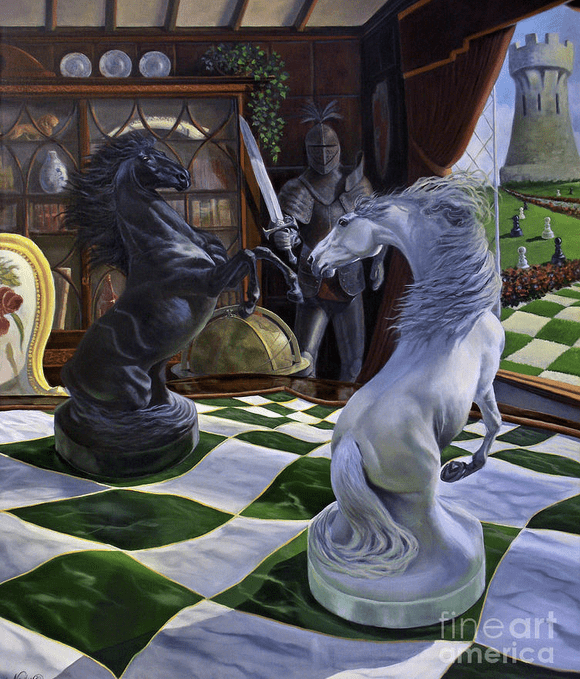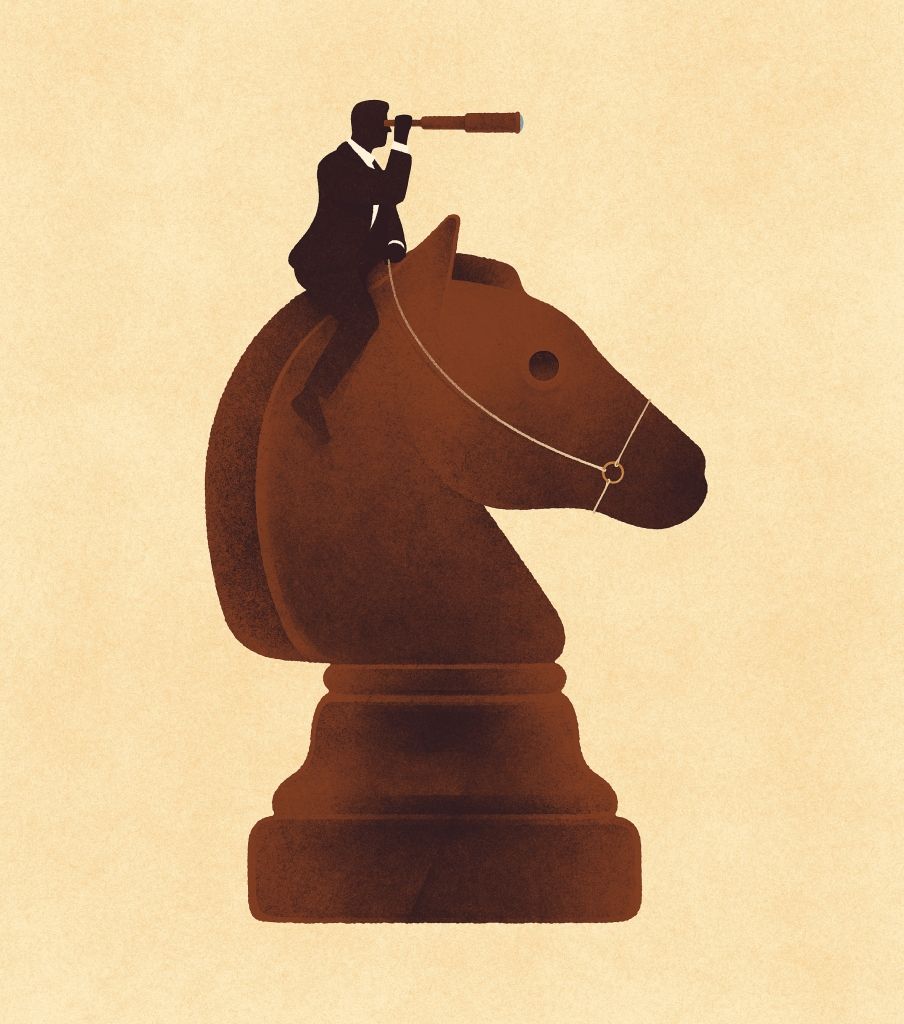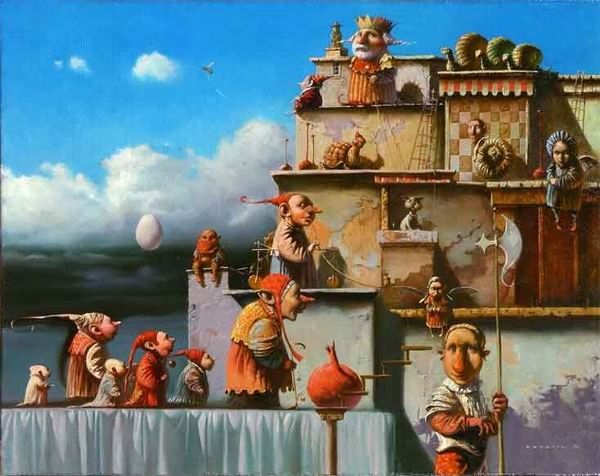Why Does Knight Move Г-Shape?
Ah, that mysterious Knight move. Where does it come from? It has arisen from the darkness of the past of early chess beginnings and stayed peculiar and enigmatic for all of us ever since. Mythical and mystical. Who knows, perhaps it is one of reasons Knight has become a cult figure of chess.
Before we get started on our elaboration on possible cues that might help us toward Knight move demystification, let's read an inspiring and enjoyable paragraph written by GM @BryanSmith about Horsey, Knight, Jumper,
"Of all the pieces, one has to admit that the Knight most illustrates the romantic aspect of chess. Symbol of an ancient institution in a society that no longer exists, and moving in a “crooked” non-linear way, unlike all the other pieces – the Knight is probably the most likely to be chosen as one’s favorite piece. And on the chessboard, the Knight – with its strange and unpredictable jumps – is the most tricky of the pieces. It is well known that in blitz, the Knight’s practical value goes up. As the game enters the final seconds, it is very easy to fall prey to a Knight’s fork."
Here's how ChessCom explains Knight move. It is pretty much the traditional explication,
Another description says Knight moves one square in any direction, then diagonally one square away from its starting square. This is the same as saying that it moves two squares straight then one square to the side.
But we can define Knight move in a completely different way. A FIDE handbook, for example, defines Knight move (p. 5) like, "It may move to one of the squares nearest to that on which it stands but not on the same rank, file or diagonal." Hmm, a bit confusing, but true.
Strictly geometrically speaking, two points define a line. And the straight line defined by Knight's starting and destination square is really the shortest line between the two points.
So instead of saying that Horsey jumps over pieces, we could imagine it simply sneaks in a stright line in between other men on the board! Or, as @Cystem_Phailure put it in a discussion on the site, "Knight basically teleports directly to its final square regardless of what's on any other squares" around.
Now, here is my hypothesis of how Knight moves originated. But first we need to see how Pawn move has possibly been invented. In the ancient times, foot soldiers would carry shields that were in the way of using their weapons like swords and axes in the forward direction. So, holding their shields, they were moving straight forward, but attacking sort of obliquely, or diagonally. And we know that infantry, the cannon food, always go forward to be wasted and sacrificed, never backwards.
Ok, now the Knight. The ancient cavalry with short weapons would also strike their enemies at an angle. But the riders were much more mobile than infantry. So, because of their greater mobility, Knight moves at a greater speed in any direction, attacking obliquely. This is the same as saying that Knight moves two squares straight in any direction, then one square to the side. Et voila. The Knight moves explained. Well, just a hypothesis on my part![]()
.
The tricky Knight moves. @MyCowsCanFly put it, "Now I have Bob Seger's song running through my head...'working on our knight moves.'"
Bob Seger & The Silver Bullet Band - Night Moves,
Workin' on mysteries without any clues
Workin' on our knight moves
Workin' on our knight moves
Ain't it funny how the knight moves
When you just don't seem to have as much to lose
Strange how the knight moves"
Knight moves, knight moves,
Knight moves, yeah.
I sure remember the knight moves
Working and practicing knight moves
Oh, the knight moves.
Yeah, yeah, yeah, I remember.

.
Here are some more ideas for practicing Knight moves, Knight tours.
 Knight Tour on the 130x130-square board
Knight Tour on the 130x130-square board
.
 Jack Tworkov (American), Study for Knight series
Jack Tworkov (American), Study for Knight series
.
 Tworkov Night series #8, 1977
Tworkov Night series #8, 1977
.
Okay, now after all these drills, let's see more Horseys as I promised last time. There were 27 Knight images back then, now you have forty-one more, not counting the above ones.
Start Bob Seger's Knight Moves video above, and enjoy...
.
 Galina Satonina
Galina Satonina
.
 Galina Satonina (Russian, 1905 – 2000), A Knight sacrifice
Galina Satonina (Russian, 1905 – 2000), A Knight sacrifice
.

Galina Satonina, Mikhail Tal, 1975
.
 Norberto Conti (Italian), Sicilian Game Knight Sacrifice
Norberto Conti (Italian), Sicilian Game Knight Sacrifice
.
 Knight's Magic, by Jeanne Newton Schoborg (American), known for Equine art, American wildlife and domestic animals
Knight's Magic, by Jeanne Newton Schoborg (American), known for Equine art, American wildlife and domestic animals
.
 Jeanne Newton Schoborg, Queen's Magic (the sequel to Knight's Magic)
Jeanne Newton Schoborg, Queen's Magic (the sequel to Knight's Magic)
.
 Knight, Staircase No3, by Tommy Fiendish (British)
Knight, Staircase No3, by Tommy Fiendish (British)
.
 Willem L. den Dunnen aka Guillaume (Dutch) Who's playing chess?
Willem L. den Dunnen aka Guillaume (Dutch) Who's playing chess?
.
 Ingeborg Ringer (Argentinian)
Ingeborg Ringer (Argentinian)
.
 The Harry Potter Knight, photo by Annie Leibovitz for Vanity Fair
The Harry Potter Knight, photo by Annie Leibovitz for Vanity Fair
.
 Chess Knight inspired by Harry Potter
Chess Knight inspired by Harry Potter
.
 Black Knight by Darx
Black Knight by Darx
.
 White Knight by Lim
White Knight by Lim
.
 Knight_takes_Rook, serograph Elke Rehder (German)
Knight_takes_Rook, serograph Elke Rehder (German)
Credit: Unknown, Raging Knight
.
 Riszard Konikowski (Polish), Horses raging on the chessboard
Riszard Konikowski (Polish), Horses raging on the chessboard
.

Ferdinand Pire (Belgian), l'Amazone
.

Centre for Computing History, Chess Player 2150
.

Credit: Unknown
.
 Knight, credit: an unknown French author
Knight, credit: an unknown French author
.

Bronze sculpture by Douwe Blumberg (American)
.

Lorenzo Quinn (the son of the Mexican-American actor Anthony Quinn)
.
 Josef Hartwig (German), Black Knight, Bauhaus chess set 1924
Josef Hartwig (German), Black Knight, Bauhaus chess set 1924
.

Jacek Yerka (Polish), Chess on island
.
 Jacek Yerka, Chess on the reef
Jacek Yerka, Chess on the reef
.
 Helping the Queen, Robert Hogfeldt (Swedish, 1894 – 1986) Schack och matt!
Helping the Queen, Robert Hogfeldt (Swedish, 1894 – 1986) Schack och matt!
.
Enki Bilal (French), Chess boxers
Chessboxing was invented by the French comic book artist Enki Bilalovic and adapted by Dutch performance artist Iepe Rubingh as an art performance and has subsequently grown into a competitive sport.
Bilal was born in Belgrade to a Czech mother, Ana, who came to Serbia as a child from Karlovy Vary (you all remember Carlsbad tournaments!), and a Bosnian father, Muhamed Bilalovic who had been the Yugoslav communist dictator Josip Broz Tito's tailor. When Enki was five years old, his father managed to take a trip and stay in Paris as a political émigré.
.
 Knight, Dan Sproul (American)
Knight, Dan Sproul (American)
.
 A poster for the 1954 Amsterdam Olympiad
A poster for the 1954 Amsterdam Olympiad
.
 Karpov not Kasparov, Valeriu Borcos and Eduard Gabia's musical game of chess between synthesizers and drums poster
Karpov not Kasparov, Valeriu Borcos and Eduard Gabia's musical game of chess between synthesizers and drums poster
.
 A beautiful design of a match-box label series, USSR, 1966. Of course, Knight got the most prominent standing over even K and Q
A beautiful design of a match-box label series, USSR, 1966. Of course, Knight got the most prominent standing over even K and Q
.
 Daiva Rozukiene (Lithuanian), Chess
Daiva Rozukiene (Lithuanian), Chess
.
 Roni Brandão (Brazilian), Cavalo de xadrez (Chess knight) 1975
Roni Brandão (Brazilian), Cavalo de xadrez (Chess knight) 1975
.
 Credit unknown
Credit unknown
.

Uh oh, that was not a chess horsey. J'adoube. But this one is![]()
.
 ? Vladimír Brádler (Czech)
? Vladimír Brádler (Czech)
.
 Victoria Ivanova (Russian)
Victoria Ivanova (Russian)
.
 The mind, Igor Maykov (Latvian)
The mind, Igor Maykov (Latvian)
.
 Edie Campbell model, photographer Tim Walker
Edie Campbell model, photographer Tim Walker
.
 Daniel Solnon (American Canadian), Chessboard, 1949
Daniel Solnon (American Canadian), Chessboard, 1949
.
 Karolis Strautniekas (Lithuanian), a business vision and strategy illustration
Karolis Strautniekas (Lithuanian), a business vision and strategy illustration
.
Looks like the strategy and vision have failed
 Frederic Schwentzel, (French, 1940) Cheval 1990
Frederic Schwentzel, (French, 1940) Cheval 1990
.

